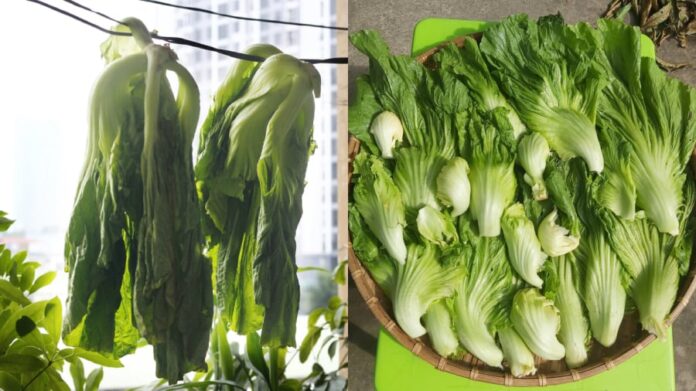Choosing the Right Vegetables for Pickling Napa Cabbage
For crisp and delicious pickled napa cabbage, opt for older, more mature cabbage heads. Younger, tender cabbage tends to turn soft and doesn’t keep as well. Older cabbage will result in a crunchier, longer-lasting pickle. Avoid heads with bruised or damaged leaves.
Preparing the Cabbage
Wash the cabbage thoroughly to remove any dirt or debris, then sun-dry it until slightly wilted. This step reduces the water content in the cabbage, resulting in a crispier pickle with less chance of spoilage. If the weather is unfavorable, simply air-dry the cabbage in a breezy spot. Collect it once the leaves start to shrivel.
If time is of the essence, you can also rinse the cabbage and blanch it in boiling water for about 10 seconds before letting it cool. While this method still yields tasty results, the pickles won’t be as vibrantly yellow as those made with the sun-drying method. Additionally, with blanching, the cabbage will be ready to eat in just 2 days.
Cut the cabbage into bite-sized pieces or leave them whole, depending on your preference. Leaving them whole will result in a longer fermentation process but will also extend the shelf life.
Ingredients for Pickling Napa Cabbage
In addition to napa cabbage, you’ll need salt, scallions, dried chili peppers, garlic, and other spices of your choice. Feel free to adjust the spices according to your taste and tradition.
Brining the Cabbage
Typically, the brine for pickling napa cabbage is made by dissolving salt in boiled and cooled water. Alternatively, you can boil the salt and water together until the salt is fully dissolved, then let the brine cool completely before use.
Tips for Faster Fermentation
– Blanch the cabbage in boiling water
As mentioned earlier, blanching the cabbage will speed up the fermentation process.
– Add vinegar and sugar to the brine
To hasten fermentation, you can include vinegar and sugar in the brine, adjusting the quantities to suit your taste. These ingredients also lend a pleasant, mild sourness to the pickles.

Enhance the pickling process and flavor by adding vinegar, sugar, or other ingredients.
– Use rice washing water
One secret to faster fermentation is to use water from washing rice. Be sure to use boiled and cooled water for rinsing the rice, then collect the starchy water (avoid using tap water for this purpose).
– Incorporate brine from previous batches
You can also speed up the fermentation process by adding some brine from your previous batch of pickled cabbage. Ensure that the old brine is free from scum and that the pickles were not spoiled or moldy.
Tips for Preventing Spoilage
– Sterilize pickling equipment
It’s crucial to sterilize your pickling equipment by rinsing and boiling them in water. Then, let them air dry before use. This step helps prevent spoilage and scum formation. Use ceramic, glass, or specialized plastic containers for pickling. If using plastic, avoid low-quality or unknown materials, as the acids produced during fermentation can leach harmful chemicals from the plastic.
– Use sufficient salt
Salt plays a vital role in inhibiting bacterial growth. Using too little salt can lead to quicker spoilage. A good rule of thumb is to use 2.5-3 teaspoons of salt per liter of water. The saltier the brine, the longer the pickles will last. However, avoid over-salting, as excessive salt intake can be detrimental to health.
– Submerge the cabbage completely in the brine
Ensure that the cabbage is fully immersed in the brine and not exposed to air. Use a clean bamboo or plastic mat, or even a clean plastic bag filled with water, to weigh down the cabbage and keep it submerged. Traditionally, a clean plate weighted down with a stone was used for this purpose.
– Use clean utensils when handling the pickles
When serving, use clean chopsticks or utensils to remove only the amount of cabbage you intend to consume. Do not return any uneaten portion to the container.
If you notice black mold or spoilage, discard the pickles and do not consume them.






























